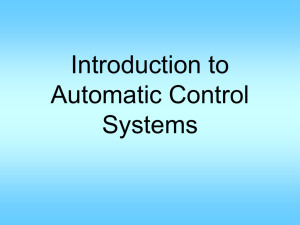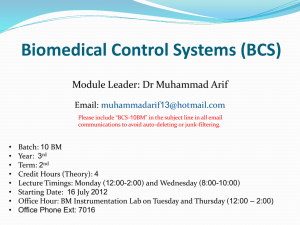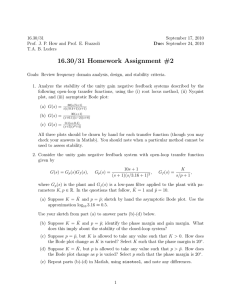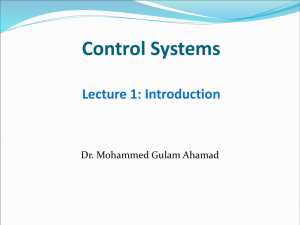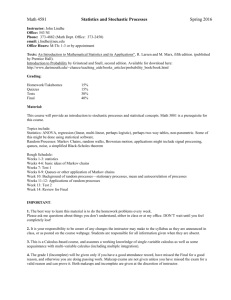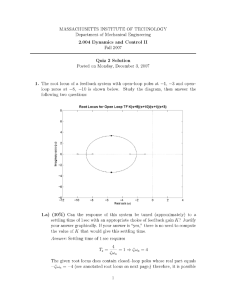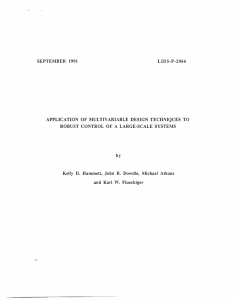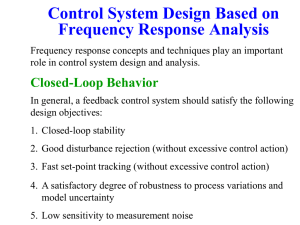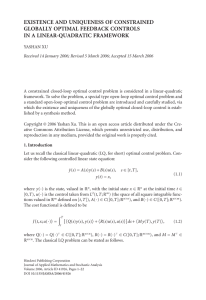File
advertisement
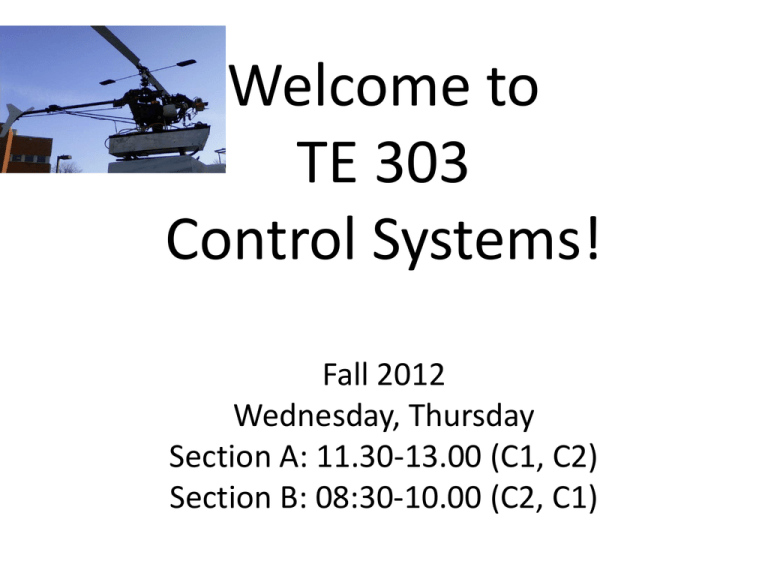
Welcome to TE 303 Control Systems! Fall 2012 Wednesday, Thursday Section A: 11.30-13.00 (C1, C2) Section B: 08:30-10.00 (C2, C1) Basic Information • Instructor Contact Information – Muhammad Ali Riaz, 2134 Coover Hall – ali.riaz@uettaxila.edu.pk; 9047-773 – Office Hours: Monday 11:30-13:00 (2k10A), Monday 10:00-11:30 (2k10B) – Or any other time convenient to you – Please include “TE 303” in the subject line in all email communications to avoid auto-deleting or junk-filtering Textbook • Modern Control Engineering Fifth Edition Katsuhiko Ogata • Reference books shall be provided later Final Grade Weighting Schedule • • • • • • Homework average: 10% Midterm exam1: 20% Final exam: 40% Quizzes: 10% Laboratory: 20% Grading Scale: Depends on class distribution Catalog Description • Classification of open and closed loop control, advantages and disadvantages • Effects of feedback, examples including servomechanism • System model and characterization, Block diagrams and canonical form • Examples of control systems from Telecom applications such as satellite Catalog Description • Signal flow graphs and Laplace Transforms, Transfer function • Poles and zeros • Time domain analysis • Steady state error using static error coefficient method • Dynamic error constant method • Feedback characteristics of control systems • Sensitivity of control systems Catalog Description • Basic action of Controllers (Proportional, Integral, PI and PID controllers) • Stability assessment (Routh, Bode, Nyquist, Nicholes chart) • Compensation and compensator design • State space Analysis Prerequisite by topics • Knowledge and proficiency in Matlab • Concept and solution of linear ordinary differential equations • Laplace transform and its applications • Poles, zeros, transfer functions, frequency response, Bode plots • Vectors and matrices • Complex numbers OBJECTIVES • On completion of TE 303, the student will be able to do the following either by hand or with the help of computation tools such as Matlab: – – – – – – – – – – – Define the basic terminologies used in controls systems Explain advantages and drawbacks of open-loop and closed loop control systems Obtain models of simple dynamic systems in ordinary differential equation, transfer function, state space, or block diagram form Obtain overall transfer function of a system using either block diagram algebra, or signal flow graphs, or Matlab tools. Compute and present in graphical form the output response of control systems to typical test input signals Explain the relationship between system output response and transfer function characteristics or pole/zero locations Determine the stability of a closed-loop control systems using the Routh-Hurwitz criteria Analyze the closed loop stability and performance of control systems based on open-loop transfer functions using the Root Locus technique Design PID or lead-lag compensator to improve the closed loop system stability and performance using the Root Locus technique Analyze the closed loop stability and performance of control systems based on open-loop transfer functions using the frequency response techniques Design PID or lead-lag compensator to improve the closed loop system stability and performance using the frequency response techniques Topics Covered • Review of signal systems concepts and techniques as applied to control system • Block diagrams and signal flow graphs • Modeling of control systems using ode, block diagrams, and transfer functions • Modeling and analysis of control systems using state space methods • Analysis of dynamic response of control systems, including transient response, steady state response, and tracking performance. • Closed-loop stability analysis using the Routh-Hurwitz criteria • Stability and performance analysis using the Root Locus techniques • Control system design using the Root Locus techniques • Stability and performance analysis using the frequency response techniques • Control system design using the frequency response techniques • If there is time, Control system design using the state space techniques Student behavior expectations • Full attendance expected, except with prior-notified excuses • On-time arrival • Active participation – Ask questions – Answer questions from instructor or students • Be cordial and considerate to students • Help each other in reviewing notes, HW, Matlab • Promptly report/share problems/issues, including typos on slides, or misspoken words from instructor Prohibited behaviors • Any foul language or gestures • Comments to other students that are discriminatory in any form • Any harassments as defined by the university • Academic dishonesty • No alcohol, drugs, or any other illegal / improper substances – Snacks/drinks OK as long as you don’t spill and clean up Accommodation/Assistance • Please let me know if you – – – – – – Have any special needs Have disability in any form Have any medical/mental/emergency conditions Have field trip / interview Have special requests Want me to adjust lecture contents/pace • Can also consult me if you – Would like to seek advice on any professional or personal issues – Would like to have certain confidential discussions Collaboration And Helping Each Other • For tasks intended for group work, you are expected to find a partner and share the tasks among the group members. In a group project, effective teamwork is critical to maximize the productivity of the whole group. In the submitted work, identify components and indicate percentage contribution by each member to each component. • For tasks not intended for group work, individual submission is required. In this case, you are encouraged to discuss among your friends on how to attack problems. However, you should write your own solution. Copying other people’s work is strictly prohibited. Academic dishonesty • Cheating is a very serious offense. It will be dealt with in the most severe manner allowable under University regulations. If caught cheating, you can expect a failing grade and initiation of a cheating case in the University system. • Basically, it’s an insult to the instructor, the department and major program, and most importantly, to the person doing the cheating. Just don't. • If in doubt about what might constitute cheating, send e-mail to your instructor describing the situation. If you notice anyone cheating, please report it to the instructor. Do not deal with it yourself. Discrimination • Federal laws as well as UET, Taxila policies prohibit any form of discrimination on the basis of race, color, age, religion, national origin, gender, marital status, or disability. Language or gestures of discriminatory nature will not be tolerated. Severe cases will be reported to appropriate offices. • Let us make every effort to work together and create a positive, collegial, caring, and all-supportive learning environment in our classroom, laboratory, and instructor office. Disability accommodation • Individuals with physical or mental impairments who are otherwise qualified to perform their work or pursue their studies may request reasonable accommodations to enable them to work or continue their studies. • If you believe you have learning disability, you must contact me right away. Control Systems History • • • • • • • • • Watt, steam engine speed control governor Black, feedback amplifiers Minorsky, ship steering stability Nyquist, closed-loop stability from open-loop Hazen, Servomechanisms Bode, Bode plot, and BP based control design Evans, root locus plot, RL based design Kalman, state space, controllability, Kalman filter Anderson…, linear optimal control Figure 1-1 Speed control system. Control Systems History • • • • • • • • • Bellman, dynamic programming Pontryagin, maximum principle Lyapunov, nonlinear systems Sastry…, adaptive control Arimoto, learning control Doyle…, robust control Byrnes/Isidori, nonlinear regulation Devasia/Chen/Paden, stable inversion Kokotovic, backstepping Control System Terminology • Input - Excitation applied to a control system from an external source. • Output - The response obtained from a system • Feedback - The output of a system that is returned to modify the input. • Error - The difference between the reference input and the output. Negative Feedback Control System + CONTROLLER - FEEDBACK ELEMENT + + CONTROLLED DEVICE Negative Feedback Control System + CONTROLLER - FEEDBACK ELEMENT + + CONTROLLED DEVICE Types of Control Systems ø Open-Loop – Simple control system which performs its function with-out concerns for initial conditions or external inputs. – Must be closely monitored. ø Closed-Loop (feedback) – Uses the output of the process to modify the process to produce the desired result. – Continually adjusts the process. Advantages of a Closed-Loop Feedback System ø Increased Accuracy – Increased ability to reproduce output with varied input. ø Reduced Sensitivity to Disturbance – By self correcting it minimizes effects of system changes. ø Smoothing and Filtering – System induced noise and distortion are reduced. ø Increased Bandwidth – Produces sat. response to increased range of input changes. Major Types of Feedback Used ø Position Feedback – Used when the output is a linear distance or angular measurement. ø Rate & Acceleration Feedback – Feeds back rate of motion or rate of change of motion (acceleration) – Motion smoothing – Uses a electrical/mechanical device call an accelerometer Fire Control Problem Present Position Ship’s Heading Bearing Change Future Position Range Change A German anti-aircraft 88 mm gun with its fire-control computer from World War II. Displayed in the Canadian War Museum. Fire Control Problem • Input – Target data – Own ship data • Computations – Relative motion procedure – Exterior ballistics procedure Fire Control Problem • Solutions – Weapons time of flight – Bearing rate – Line of Sight(LOS): The line between the target and the firing platform – Speed across LOS – Future target position – Launch angles • Launch azimuth • Launch elevation – Weapon positioning orders • The above determines weapon trajectory: The line the weapon must travel on to intercept the target. The Iterative Process to the Fire Control Solution Step 1 Step 2 Step 3 Last Step A 3-Dimensional Problem Line of Sight Target Elevation Gun Elevation Horizontal Reference Plane Solving the Fire Control Problem Continuously Measure Present Target Position Stabilize Measured Quantities Compute Relative Target Velocity Environmental Inputs Weapons Positioning orders Unstabilized Launch Angles Ballistic Calculations Launch Angles (Stabilized) Future Target Position Time of Flight Relative Motion Calculations Prediction Procedure Temperature control system. Block diagram of an engineering organizational system. Idle-speed control system. Conceptual method of efficient water extraction using solar power. Important components of the sun-tracking control system. Antenna azimuth position control system: a. system concept; b. detailed layout; c. schematic; d. functional block diagram a. Video laser disc player; b. objective lens reading pits on a laser disc; c. optical path for playback showing tracking mirror rotated by a control system to keep the laser beam positioned on the pits. (a) (b) (c) © Pioneer Electronics, Inc. Computer hard disk drive, showing disks and read/write head Courtesy of Quantum Corp. High gain; fast but oscillating Response of a position control system showing effect of high and low controller gain on the output response Control goal; fast reaction, lower overshoot, less settling time
